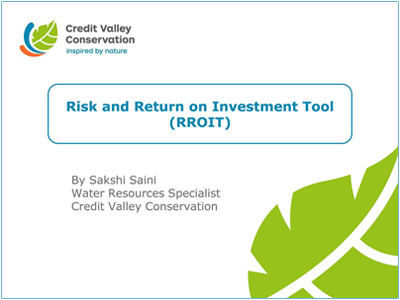TRACK 1
Risk and Return on Investment Tool for Flood Mitigation Under Current and Future Climate
ABSTRACT
Climate change is expected to result in more extreme weather, leading to an increase in natural disasters and property damage, record-breaking insured losses, and disaster relief costs.
With such risks and associated costs, it is increasingly important for decision-makers to understand the locations, drivers and range in solutions, to mitigate risk and make evidence-based decisions.
Grants from the Disaster Mitigation Action Fund (DMAF) and Infrastructure Canada’s Climate Change Lens both require a climate change risk assessment and return on investment analyses as prerequisites to demonstrate a best management practice approach.
The National Disaster Mitigation Program Stream 3 funding also requires flood mitigation plans to consider climate change and identify high-risk areas, with consideration for municipal services and social vulnerability.
Credit Valley Conservation and Risk Sciences International Inc., with support from the National Disaster Mitigation Program, have developed a Risk and Return on Investment Tool (RROIT) to address these gaps.
The tool is intended to help municipalities and conservation authorities identify areas of high risk and make cost-effective decisions for flood risk mitigation.
RROIT currently assesses the economic and social impacts of riverine flooding, as well as urban overland flooding, storm sewer back-up, sanitary sewer back-up, and stream erosion. The tool performs a financial assessment of management options to help users optimize their investment.
This presentation will provide an overview of the design, including a demonstration of input requirements and the types of outputs generated by the tool.
Learning Objectives
1. Learn how the Risk and Return on Investment Tool can help meet federal government requirements, such as Disaster Mitigation Action Fund or Climate Lens requirements, as well as the National Disaster Mitigation Program Flood Mitigation Planning stream, and Provincial requirements such as the Growth Plan for the Greater Golden Horseshoe
2. Learn about the requirements for using the Risk and Return on Investment Tool, and whether you are eligible for a case study application
3. Review and understand sample results from a case study application in Mississauga
ABOUT THE PRESENTER

Sakshi Saini
Sakshi Saini is a water resources specialist in the Water and Climate Change Science Division at Credit Valley Conservation (CVC).
Sakshi joined the Credit Valley Conservation Authority in November 2014 and works on low impact development modeling, municipal natural assets modeling and valuation, and flood risk assessment studies and tools development.
Sakshi is also a flood duty officer and a spills response coordinator at CVC.

